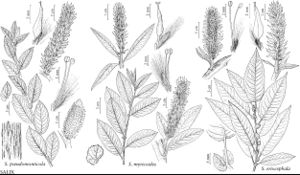Salix eriocephala
Fl. Bor.-Amer. 2: 225. 1803.
Shrubs, 0.2–6 m, (sometimes forming clones by stem fragmentation). Stems: branches (sometimes highly brittle at base), redbrown, not glaucous, glabrous or glabrescent; branchlets yellowbrown to redbrown, pilose, moderately to densely velvety, pubescent, or villous, (inner membranaceous bud-scale layer free). Leaves: stipules foliaceous, (4.5–13 mm), apex rounded or acute; petiole shallowly grooved adaxially, 3–18 mm, tomentose adaxially; largest medial blade narrowly oblong, very narrowly elliptic or obovate, 58–96–136 × 9–21–36 mm, 2.3–4.6–8 times as long as wide, base cordate, convex, rounded, subcordate, or, sometimes, cuneate, margins flat, serrate or serrulate, apex acute to acuminate, abaxial surface thickly glaucous, glabrous, puberulent, sparsely pubescent or short-silky, adaxial highly glossy, glabrous or sparsely villous (hairs white, sometimes also ferruginous); proximal blade margins entire or shallowly serrulate; juvenile blade reddish or yellowish green, glabrous, pilose, or villous abaxially, hairs white. Catkins: staminate flowering just before leaves emerge, pistillate as leaves emerge; staminate slender or stout, 19–44 × 7–14 mm, flowering branchlet 0.5–5 mm; pistillate densely or moderately densely flowered, slender or stout, 22–65 × 7–14 mm, flowering branchlet 2–10 mm; floral bract dark-brown or bicolor, 0.8–1.6 mm, apex rounded, abaxially hairy, hairs wavy. Staminate flowers: adaxial nectary narrowly oblong, oblong, or ovate, 0.2–1 mm; filaments distinct or connate less than 1/2 their lengths, glabrous; anthers yellow or purple turning yellow (ellipsoid or shortly cylindrical), 0.4–0.6 mm. Pistillate flowers: adaxial nectary oblong or flask-shaped, 0.3–0.8 mm, shorter than stipe; stipe 1.2–2.8 mm; ovary pyriform, glabrous, beak slightly bulged below styles; ovules 12–16 per ovary; styles 0.3–0.6 mm; stigmas flat, abaxially non-papillate with rounded tip, or broadly cylindrical, or 2 plump lobes, 0.16–0.28 mm. Capsules 3.5–7 mm. 2n = 38.
Phenology: Flowering early Apr-mid Jun.
Habitat: Gravelly or rocky stream banks, marshy fields, in mixed mesophytic woods on alluvium
Elevation: 0-1200 m
Distribution

N.B., Nfld. and Labr. (Nfld.), N.S., Ont., P.E.I., Que., Ala., Ark., Conn., Del., D.C., Fla., Ga., Ill., Ind., Iowa, Kans., Ky., Maine, Md., Mass., Mich., Minn., Mo., Nebr., N.H., N.J., N.Y., N.Dak., Ohio, Pa., R.I., S.Dak., Tenn., Vt., Va., W.Va., Wis.
Discussion
Salix eriocephala sometimes is very difficult to separate from S. myricoides. Some of the confusion may be due to hybridization but no definite hybrids have been seen.
Salix eriocephala can be distinguished from S. myricoides by having stipules on early leaves foliaceous, apices acute to rounded, largest medial blades 4.9–23.3 times as long as petiole, abaxial surface usually thickly glaucous (stomata can be seen through the grayish wax), margins serrulate or serrate, floral bracts 0.8–1.6 mm, moderately to very densely hairy, styles 0.3–0.6 mm, and stigmas 0.16–0.28 mm; S. myricoides has stipules on early leaves rudimentary or foliaceous, apices acuminate or acute, largest medial blades 4.7–13.4 times as long as petiole, abaxial surface usually with very thick wax (stomata cannot be seen through the wax), margins crenulate to serrulate, floral bracts 1.2–3 mm, sparsely to moderately densely hairy, styles 0.3–1.3 mm, and stigmas 0.28–0.56 mm.
Hybrids:
Salix eriocephala forms natural hybrids with S. candida, S. famelica, S. humilis, S. interior, S. lasiandra, S. petiolaris, and S. sericea. Hybrids with S. amygdaloides, S. bebbiana, S. myricoides, and S. pedicellaris have been reported (M. L. Fernald 1950) but no convincing specimens have been seen. Controlled pollinations made with S. discolor had low success and many seedlings were abnormal (A. Mosseler 1990). In controlled pollination using S. eriocephala as the maternal parent, seeds were rarely produced due to pollen-stigma incompatibility (Mosseler 1989).
Salix eriocephala × S. famelica: Hybrids and intergrades occur in the area of overlap (R. D. Dorn 1995). Specimens from a population in Douglas County, Nebraska, which included successive collections and cultivated specimens, have branches with yellow-mottled coloration of S. famelica and villous indumentum of S. eriocephala; they may be this hybrid.
Salix eriocephala × S. petiolaris: Controlled pollinations (A. Mosseler 1990) had low seed-set but a high percent of seed germination and seedling survival. Because reproductive barriers between these species are weak, it was suggested that their morphological variability may be due to interspecific gene flow (Mosseler). Natural hybrids are known from Illinois, Maine, Massachusetts, Michigan, Missouri, New York, Ontario, Quebec, and West Virginia.
Salix eriocephala × S. sericea: This hybrid is relatively common wherever the ranges of the parents overlap. It has been studied in the southeastern United States (G. W. Argus 1986) and in eastern Canada. The results of a molecular study (T. M. Hardig et al. 2000) have been discussed already under the genus. In general, the hybrids resemble S. eriocephala but have leaves that are sparsely to moderately densely short-silky on abaxial surfaces and ovaries hairy as in S. sericea. Foliaceous stipules are often present on late leaves and sometimes even on early leaves, as in S. eriocephala, but they are not as prominent. In S. sericea stipules usually are lacking or rudimentary, but on late leaves they may be foliaceous. Petioles and branchlets of hybrids are finely velvety as in S. sericea. This hybrid was described from Maine (O. W. Knight 1907), where it was noted that the catkins were usually abortive but sometimes produced one or two fertile seeds.
Salix eriocephala is distinguished from S. sericea in having stipules on early and late leaves foliaceous, 4–6.2–8.3 × 2.5–3.6–4.6 mm, 1.5–2 times as long as wide, ovaries glabrous, juvenile blades glabrous or sparsely hairy, hairs white, largest medial blade abaxial surfaces glabrous, puberulent, sparsely pubescent, or short-silky, stipes 1.2–2.8 mm, and capsules 3.5–7 mm; S. sericea has stipules on early leaves absent or rudimentary, on late leaves rudimentary to foliaceous, 1.1–1.6–2.1 × 0.4–0.6–0.8 mm, 2.3–3 times as long as wide, ovaries short-silky, juvenile blades very densely short-silky, hairs white, sometimes also ferruginous, largest medial blade abaxial surfaces densely short-silky, stipes 0.6–1.5 mm, and capsules 2.5–4 mm.
Selected References
None.
Lower Taxa
"-136mm" is not declared as a valid unit of measurement for this property."-36mm" is not declared as a valid unit of measurement for this property.
